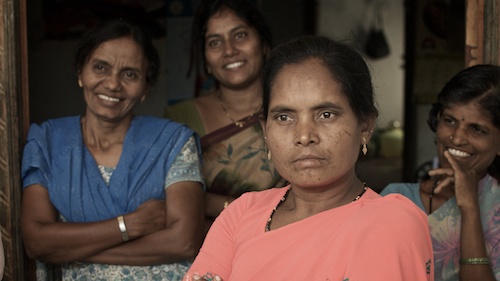I’ve been asked to go to Haiti in July to document the work of a trauma therapy team (more on that very soon). Since returning from India, I’ve had some serious thought considering the nature of what I do in the field. I can, because of the power dynamics involved, go in and make images of vulnerable peoples without many hindrances. I am a white American with the power to enter into their world and exit freely; there are usually no questions asked or the permission for me to work is implicit (either from the unspoken understanding that ‘I’m here to help’ or some manner of unintentional intimidation on my part or the people I represent when working). I want to begin sorting through this before going out on assignment again.
This was at a rural village in India during a health clinic. Who are these children and how do their lives connect with yours? What gives me the right to force that connexion?
In Haiti we will work with children who have lost both parents in the earthquake. They are physically and psychologically traumatised from the disaster; many live now on one meal of beans and rice a day (if that) and they have little emotional nourishment either. These are children who, at this time, have no say in the course of their lives; they are completely dependent on orphanages and aid agencies such as the one I will work with. I wish to consider how I obtain ‘permission’ to document the condition they are in. By this, I don’t mean ‘legal permission’; that is obtained easily enough from those acting in loco parentis. I want to consider how to enter into a situation where I am essentially the only one with apparent power and give people the ability to play a role in how they are portrayed.
I work mainly with NGOs who attempt, ostensibly, to ‘make the world a better place.’ My thought when I make an image of a person ‘over there’ who is vulnerable and ‘in need of our help’ is that this image will help the larger group of people represented by it. However, this person in the image is not a larger group—this is a person who I have chosen to capture in an image at a particular moment at a particular time; they have a specific life that brought us together at a particular 1/125th of a second. After that moment is over, what gives me the right to step away from them forever and present them as representative of a group? The argument that the larger whole is served may be in some way valid; but what of that specific person presented in the image? If they are not helped in some way, is there a violence done to them? (Consider this in the inverse; when you see the image of an angry young Arab man what is the first impulse in your mind? What is the implication of the stone throwing man in the picture? That these people as a whole are angry and violent? Does he truly represent the group or is he an isolated individual? What violence to truth is accomplished both by the picture of the child with files in his eyes and the man with a Molotov Cocktail?)
Also, have we truly asked if ‘they’ want our help? It is assumed that the distressed people over there want and need our assistance; however, I think we must take care of the Great White Saviour Syndrome. It can be safely assumed that many of the people we encounter in these situations do wish our presence and welcome assistance; however, the assumption does not give us licence to do further harm to already vulnerable people by exploiting them for our own good purposes. It’s a fine line to ride; but I think it’s imperative to consider it deeply. There are more parties involved than just the photographer and the subject as well; we must consider to what end these images are used. The viewer must react in some way...either by taking some action to remedy the situation or not. The act of viewing an image places moral responsibility on the viewer to respond; they are, in some sense, ‘present’ in the situation brought to them by the image (this is the same argument used when prosecuting pedophiles who are found with child pornography; they have participated in the abuse even if they were not physically present when the image was made).
Health workers in India; what are their stories and does a four word caption in any way do justice to the lives they lead and the work they do for rural poor people?
There is a chain of communication I want to consider; from the person photographed, the photographic process itself (and the alterations it inevitably makes to the ‘real’), myself as a photographer, and the viewer. It’s not just going in and snapping some photos; I’m starting to work at the margins of the world where moral questions reach their frayed ends.


